Owner Maintenance
Owner Maintenance Precautions
The owner or a qualified service technician should make these vehicle inspections at the indicated intervals to ensure safe and dependable operation.
Bring any problem to the attention of an Authorized Mazda Dealer or qualified service technician as soon as possible.
When Refueling
-
Brake fluid level (Search)
-
Engine coolant level (Search)
-
Engine oil level (Search)
-
Washer fluid level (Search)
At Least Monthly
-
Tire inflation pressures (Search)
At Least Twice a Year (For Example, Every Spring and Fall)
You can do the following scheduled maintenance items if you have some mechanical ability and a few basic tools and if you closely follow the directions in this manual.
Improper or incomplete service may result in problems. This section gives instructions only for items that are easy to perform.
As explained in the Introduction (Search), several procedures can be done only by a qualified service technician with special tools.
Improper owner maintenance during the warranty period may affect warranty coverage. Refer to Introduction (Search) for owner's responsibility in protecting your investment. For details, read the separate Mazda Warranty statement provided with the vehicle. If you are unsure about any servicing or maintenance procedure, have it done by an Authorized Mazda Dealer.
There are strict environmental laws regarding the disposal of waste oil and fluids. Please dispose of your waste properly and with due regard to the environment.
We recommend that you entrust the oil and fluid changes of your vehicle to an Authorized Mazda Dealer.
Do not perform maintenance work if you lack sufficient knowledge and experience or the proper tools and equipment to do the work. Have maintenance work done by a qualified technician:
Performing maintenance work on a vehicle is dangerous if not done properly. You can be seriously injured while performing some maintenance procedures.
If you must run the engine while working under the hood, make certain that you remove all jewelry (especially rings, bracelets, watches, and necklaces) and all neckties, scarves, and similar loose clothing before getting near the engine or cooling fan which may turn on unexpectedly:
Working under the hood with the engine running is dangerous. It becomes even more dangerous when you wear jewelry, loose clothing or have long hair or a long beard.
Either can become entangled in moving parts and result in injury.
 Pull over to a safe location, then switch the ignition off and make sure the fan is not running before attempting to work near the cooling fan:
Pull over to a safe location, then switch the ignition off and make sure the fan is not running before attempting to work near the cooling fan:
Working near the cooling fan when it is running is dangerous. The fan could continue running indefinitely even if the engine has stopped and the engine compartment temperature is high. You could be hit by the fan and seriously injured.
Do not leave items in the engine compartment:
After you have finished checking or doing servicing in the engine compartment, do not forget and leave items such as tools or rags in the engine compartment.
Tools or other items left in the engine compartment could cause engine damage or a fire leading to an unexpected accident.
Opening the Hood
-
With the vehicle parked, pull the release handle to unlock the hood.
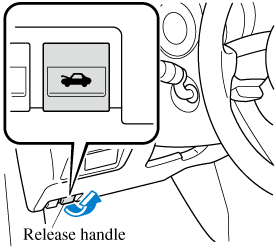
-
Insert your hand into the hood opening, slide the latch lever to the right, and lift up the hood.
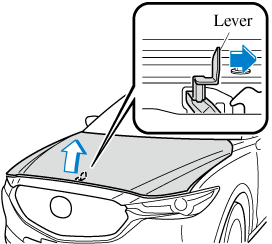
-
Grasp the support rod in the padded area and secure it in the support rod hole indicated by the arrow to hold the hood open.
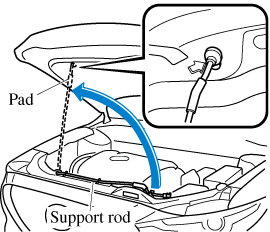
Engine Compartment Overview

Recommended Oil
U.S.A., Canada
SKYACTIV-G 2.5
Use SAE 0W-20 engine oil.
Mazda Genuine Oil is used in your Mazda vehicle. Mazda Genuine 0W-20 Oil is required to achieve optimum fuel economy.
For maintenance service, Mazda recommends Genuine Mazda Parts and Genuine Mazda Premium Oil.
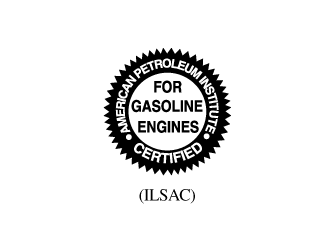
Only use SAE 0W-20 oil “Certified For Gasoline Engines” by the American Petroleum Institute (API).
Oil with this trademark symbol conforms to the current engine and emission system protection standards and fuel economy requirements of the International Lubricant Standardization and Approval Committee (ILSAC), comprised of U.S. and Japanese automobile manufacturers.
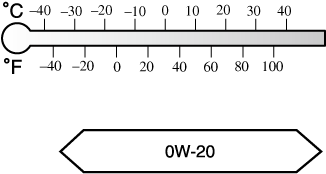
SKYACTIV-G 2.5T
Use SAE 5W-30 engine oil.
Mazda Genuine Oil is used in your Mazda vehicle. Mazda Genuine 5W-30 Oil is required to achieve optimum fuel economy.
For maintenance service, Mazda recommends Genuine Mazda Parts and Genuine Mazda Premium Oil.

Only use SAE 5W-30 oil “Certified For Gasoline Engines” by the American Petroleum Institute (API).
Oil with this trademark symbol conforms to the current engine and emission system protection standards and fuel economy requirements of the International Lubricant Standardization and Approval Committee (ILSAC), comprised of U.S. and Japanese automobile manufacturers.
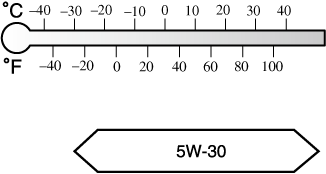
Except U.S.A., Canada
SKYACTIV-G 2.5
Use SAE 5W-30 engine oil.
Oil container labels provide important information.
A chief contribution this type of oil makes to fuel economy is reducing the amount of fuel necessary to overcome engine friction.
For maintenance service, Mazda recommends Mazda Genuine Parts.

(Mexico)

SKYACTIV-G 2.5
Use API SM or higher, SAE 5W-30 engine oil. If SAE 5W-30 engine oil is not available, use SAE 5W-20, SAE 0W-30 or SAE 10W-30 engine oil.
The quality designation SM, SN or SP must be on the label.
SKYACTIV-G 2.5T
Use API SM or higher, SAE 5W-30 engine oil. If SAE 5W-30 engine oil is not available, use SAE 0W-30 or SAE 10W-30 engine oil.
The quality designation SM, SN or SP must be on the label.
Inspecting Coolant Level
Do not use a match or live flame in the engine compartment. DO NOT ADD COOLANT WHEN THE ENGINE IS HOT:
A hot engine is dangerous. If the engine has been running, parts of the engine compartment can become very hot. You could be burned. Carefully inspect the engine coolant in the coolant reservoir, but do not open it.
 Do not touch rotating parts such as the fan belt when inspecting inside the engine compartment:
Do not touch rotating parts such as the fan belt when inspecting inside the engine compartment:
Working near the cooling fan when it is running is dangerous. The fan could continue running indefinitely even if the engine has stopped and the engine compartment temperature is high. You could be hit by the fan and seriously injured.
 Do not remove either cooling system cap when the engine and radiator are hot:
Do not remove either cooling system cap when the engine and radiator are hot:
When the engine and radiator are hot, scalding coolant and steam may shoot out under pressure and cause serious injury.
Inspect the antifreeze protection and coolant level in the coolant reservoir at least once a year―at the beginning of the winter season―and before traveling where temperatures may drop below freezing.
Inspect the condition and connections of all cooling system and heater hoses.
Replace any that are swollen or deteriorated.
The coolant should be at full in the radiator and between the F and L marks on the coolant reservoir when the engine is cool.
SKYACTIV-G 2.5
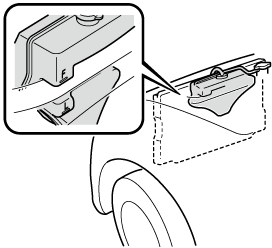
SKYACTIV-G 2.5T
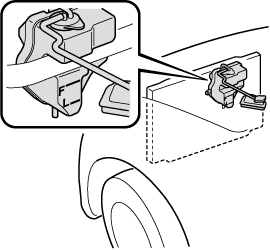
If it is at or near L, add enough coolant to the coolant reservoir to provide freezing and corrosion protection and to bring the level to F.
Securely tighten the coolant reservoir tank cap after adding coolant.
-
Radiator coolant will damage paint.
Rinse it off quickly if spilled.
-
If the “FL22” mark is shown on or near the cooling system cap, use of FL-22 is recommended when replacing engine coolant. Using engine coolant other than FL-22 may cause serious damage to the engine and cooling system.
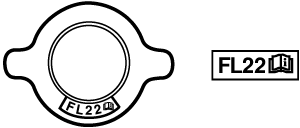
If the coolant reservoir is empty or new coolant is required frequently, consult an Authorized Mazda Dealer.
Brake Fluid
Inspecting Brake Fluid Level
If the brake fluid level is low, have the brakes inspected:
A low brake fluid level is dangerous.
A low level could indicate brake lining wear or a brake system leak which could cause the brakes to fail and lead to an accident.
Inspect the fluid level in the reservoir regularly. It should be kept between the MAX and MIN lines.
The level normally drops with accumulated distance, a condition associated with wear of brake linings. If it is excessively low, have the brake system inspected by an Authorized Mazda Dealer.

Inspecting Washer Fluid Level
Use only windshield washer fluid or plain water in the reservoir:
Using radiator antifreeze as washer fluid is dangerous. If sprayed on the windshield, it will dirty the windshield, affect your visibility, and could result in an accident.
Using Washer Fluid Without Anti-freeze Protection in Cold Weather:
Operating your vehicle in temperatures below 4 °C (40 °F) using washer fluid without anti-freeze protection is dangerous as it could cause impaired windshield vision and result in an accident. In cold weather, always use washer fluid with anti-freeze protection.
State or local regulations may restrict the use of volatile organic compounds (VOCs), which are commonly used as anti-freeze agents in washer fluid. A washer fluid with limited VOC content should be used only if it provides adequate freeze resistance for all regions and climates in which the vehicle will be operated.
Add washer fluid under any of the following conditions.
-
The top of the fluid level is low.
-
The Low Washer Fluid Level Warning Indication/Warning Light (if equipped) turns on.
-
The top of the fluid level is lower than L (if equipped).
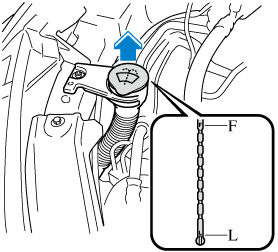
Use plain water if washer fluid is unavailable.
But use only washer fluid in cold weather to prevent it from freezing.
Body Lubrication
All moving points of the body, such as door and hood hinges and locks, should be lubricated each time the engine oil is changed. Use a nonfreezing lubricant on locks during cold weather.
Make sure the hood's secondary latch keeps the hood from opening when the primary latch is released.
Wiper Blades
-
Hot waxes applied by automatic car washers have been known to affect the wiper's ability to clean windows.
-
To prevent damage to the wiper blades, do not use gasoline, kerosene, paint thinner, or other solvents on or near them.
-
When the wiper lever is in the AUTO position and the ignition is switched ON, the wipers may move automatically in the following cases:
-
If the windshield above the rain sensor is touched.
-
If the windshield above the rain sensor is wiped with a cloth.
-
If the windshield is struck with a hand or other object.
-
If the rain sensor is struck with a hand or other object from inside the vehicle.
Be careful not to pinch hands or fingers as it may cause injury, or damage the wipers. When washing or servicing the vehicle, make sure the wiper lever is in the OFF position.
-
Contamination of either the windshield or the blades with foreign matter can reduce wiper effectiveness. Common sources are insects, tree sap, and hot wax treatments used by some commercial car washes.
If the blades are not wiping properly, clean the window and blades with a good cleaner or mild detergent; then rinse thoroughly with clean water. Repeat if necessary.
Battery Replacement
Contact an Authorized Mazda Dealer for battery replacement.
Replacing a Wheel
Always use wheels of the correct size on your vehicle:
Using a wrong-sized wheel is dangerous. Braking and handling could be affected, leading to loss of control and an accident.
A wrong-sized wheel may adversely affect:
-
Tire fit
-
Wheel and bearing life
-
Ground clearance
-
Snow-chain clearance
-
Speedometer calibration
-
Headlight aim
-
Bumper height
-
Tire Pressure Monitoring System
-
When replacing a wheel, make sure the new one is the same as the original factory wheel in diameter, rim width, and offset (inset/outset).
-
For details, contact an Authorized Mazda Dealer.
Proper tire balancing provides the best riding comfort and helps reduce tread wear. Out-of-balance tires can cause vibration and uneven wear, such as cupping and flat spots.
Fuse Panel Description
Fuse block (Engine compartment)
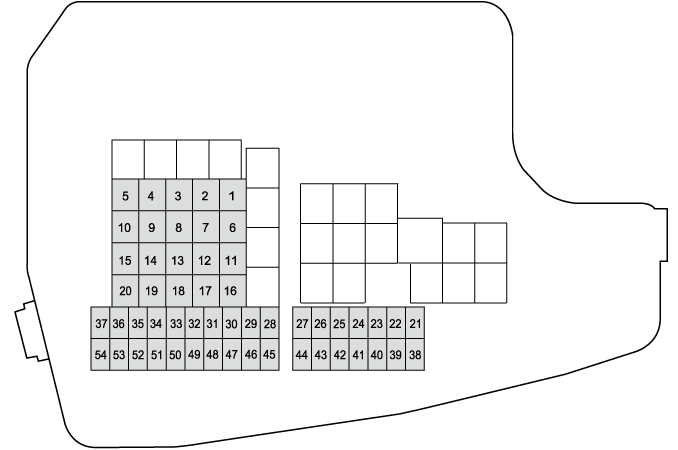
|
DESCRIPTION |
FUSE RATING |
PROTECTED COMPONENT |
|
|---|---|---|---|
|
1 |
CABIN.+B |
50 A |
For protection of various circuits |
|
2 |
IG2 |
30 A |
For protection of various circuits |
|
3 |
INJECTOR ENG.SUB |
30 A |
Engine control system (Some Models) |
|
4 |
SCR1 EVVT |
20 A |
Engine control system (Some Models) |
|
5 |
P.WINDOW1 |
30 A |
Power windows (Some Models) |
|
6 |
R.HEATER |
20 A |
― |
|
7 |
ADD FAN DE |
40 A |
Cooling fan (Some Models) |
|
8 |
WIPER.DEI |
20 A |
Windshield wiper de-icer (Some Models) |
|
9 |
DEFOG |
30 A |
Rear window defogger |
|
10 |
DCDC DE |
40 A |
For protection of various circuits |
|
11 |
EPB R |
20 A |
Electric parking brake (EPB) (RH) |
|
12 |
EPB L |
20 A |
Electric parking brake (EPB) (LH) |
|
13 |
AUDIO DCDC REG |
30 A |
Audio system (Some Models) |
|
14 |
FAN GE |
30 A |
Cooling fan (Some Models) |
|
15 |
ENG.MAIN |
40 A |
Engine control system |
|
16 |
ABS/DSC M |
50 A |
ABS, Dynamic stability control system |
|
17 |
FAN DE |
40 A |
Cooling fan (Some Models) |
|
18 |
WIPER |
20 A |
Front window wiper and washer |
|
19 |
HEATER |
40 A |
Air conditioner |
|
20 |
ADD FAN GE |
30 A |
Cooling fan (Some Models) |
|
21 |
ENGINE.IG1 |
7.5 A |
Engine control system |
|
22 |
C/U IG1 |
15 A |
For protection of various circuits |
|
23 |
AUDIO2 |
7.5 A |
Audio system |
|
24 |
METER2 |
7.5 A |
Instrument cluster (Some Models) |
|
25 |
ENGINE3 |
15 A |
Engine control system |
|
26 |
ENGINE2 |
15 A |
Engine control system |
|
27 |
ENGINE1 |
15 A |
Engine control system (Some Models) |
|
28 |
AT |
15 A |
Transaxle control system, Ignition switch |
|
29 |
H/CLEAN |
20 A |
― |
|
30 |
A/C |
7.5 A |
Air conditioner |
|
31 |
AT PUMP |
15 A |
Transaxle control system (Some Models) |
|
32 |
HORN |
15 A |
Horn |
|
33 |
R.WIPER |
15 A |
Rear window wiper |
|
34 |
H/L HI |
20 A |
Headlight high beam |
|
35 |
ST.HEATER |
15 A |
Heated steering wheel (Some Models) |
|
36 |
FOG |
15 A |
― |
|
37 |
ENG.+B |
7.5 A |
Engine control system |
|
38 |
H/L LOW L |
15 A |
Headlight low beam (LH) |
|
39 |
ENGINE4 |
15 A |
Engine control system (Some Models) |
|
40 |
INTERIOR1 |
15 A |
For protection of various circuits (Some Models) |
|
41 |
METER1 |
10 A |
Instrument cluster |
|
42 |
SRS1 |
7.5 A |
Air bag |
|
43 |
AUDIO1 |
15 A |
Audio system |
|
44 |
BOSE |
25 A |
Bose Sound System-equipped model (Some Models) |
|
45 |
ABS/DSC S |
30 A |
ABS, Dynamic stability control system |
|
46 |
FUEL PUMP |
15 A |
Fuel system (Some Models) |
|
47 |
FUEL WARM |
25 A |
Fuel warmer (Some Models) |
|
48 |
TAIL |
15 A |
Taillights, License plate lights, Parking lights |
|
49 |
SCR2 FUEL PUMP2 |
25 A |
― |
|
50 |
HAZARD |
25 A |
Hazard warning flashers, Turn signal lights, Parking lights |
|
51 |
H/L LOW R |
15 A |
Headlight low beam (RH) |
|
52 |
OUTLET |
25 A |
Accessory sockets |
|
53 |
STOP |
10 A |
Brake lights |
|
54 |
ROOM |
25 A |
For protection of various circuit |
Fuse block (Left side)
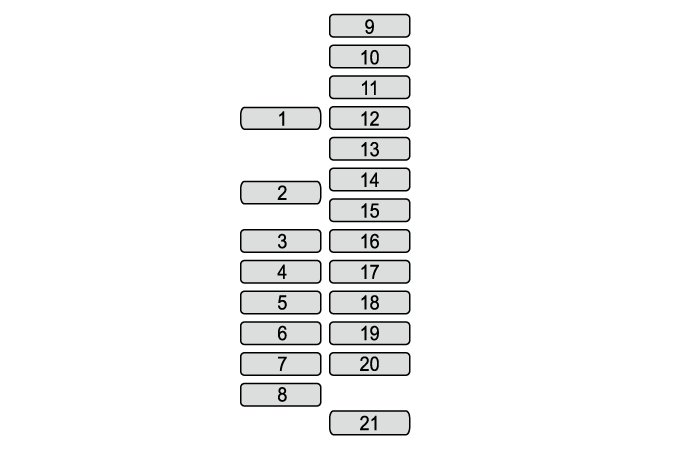
|
DESCRIPTION |
FUSE RATING |
PROTECTED COMPONENT |
|
|---|---|---|---|
|
1 |
P.SEAT D |
30 A |
Power seat (Some Models) |
|
2 |
P.WINDOW3 |
30 A |
Power windows |
|
3 |
R.OUTLET3 |
15 A |
Accessory sockets (Some Models) |
|
4 |
P.WINDOW2 |
25 A |
Power windows |
|
5 |
ESCL |
15 A |
Trailer hitch (Some Models) |
|
6 |
D.LOCK |
25 A |
Power door locks |
|
7 |
SEAT WARM |
20 A |
Seat warmer (Some Models) |
|
8 |
SUNROOF |
10 A |
Moonroof (Some Models) |
|
9 |
F.OUTLET |
15 A |
Accessory sockets |
|
10 |
MIRROR |
7.5 A |
Power control mirror |
|
11 |
R.OUTLET1 |
15 A |
― |
|
12 |
SCR3 |
15 A |
― |
|
13 |
SCR4 |
15 A |
― |
|
14 |
R.OUTLET2 |
15 A |
Accessory sockets |
|
15 |
USB |
7.5 A |
USB power outlet (Some Models) |
|
16 |
PLG |
20 A |
Power liftgate (Some Models) |
|
17 |
M.DEF |
7.5 A |
Mirror defogger (Some Models) |
|
18 |
R.SEAT W |
20 A |
Rear seat warmer (Some Models) |
|
19 |
INTERIOR2 |
15 A |
For protection of various circuit |
|
20 |
AT IND |
7.5 A |
AT shift indicator |
|
21 |
P.SEAT P |
30 A |
Power seat (Some Models) |










































